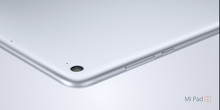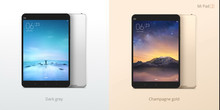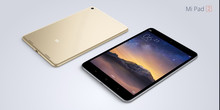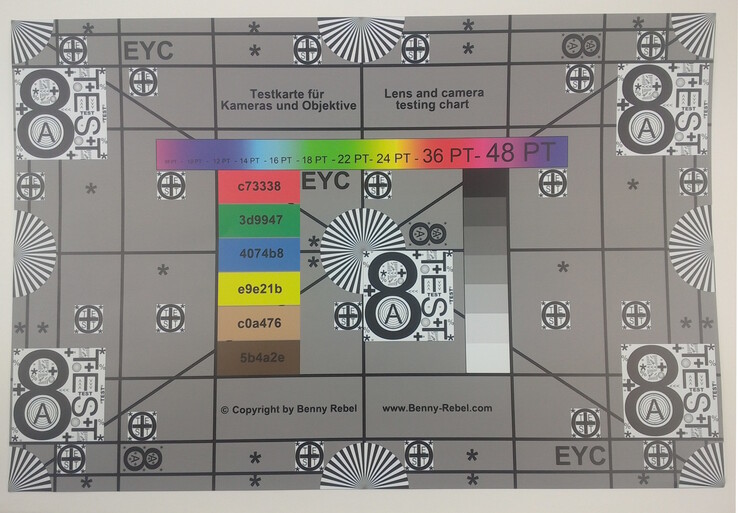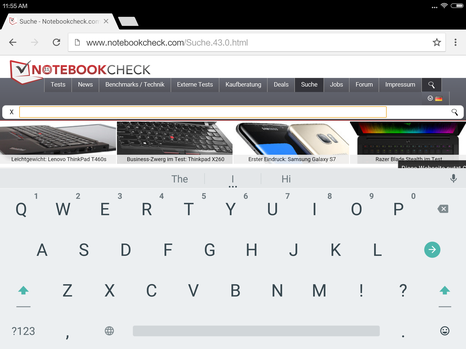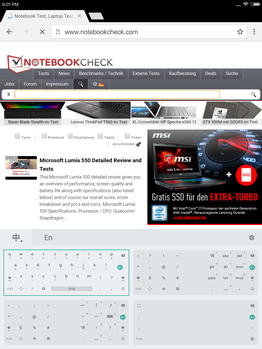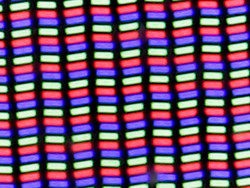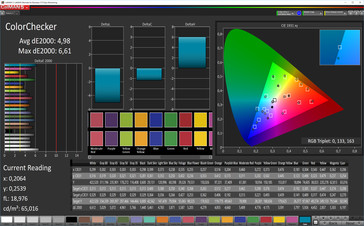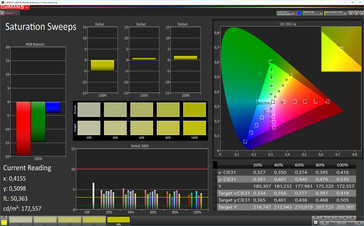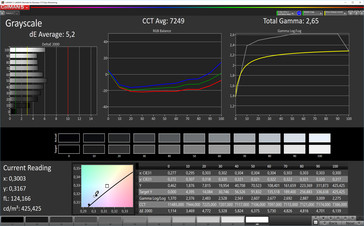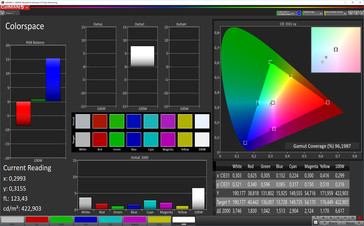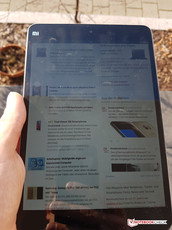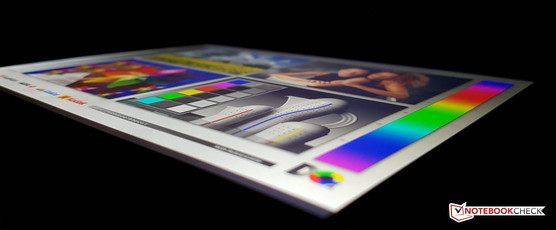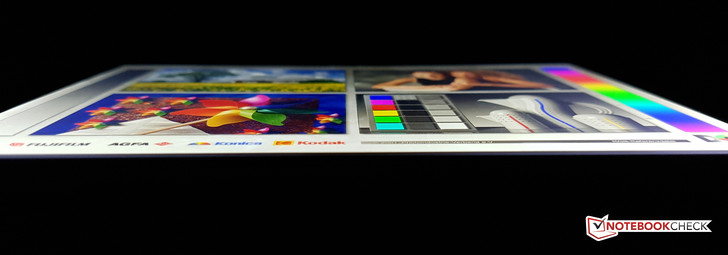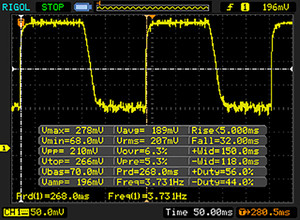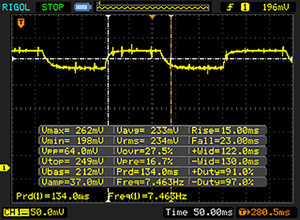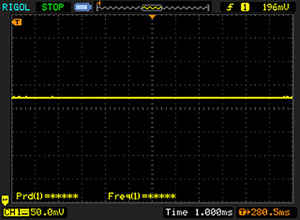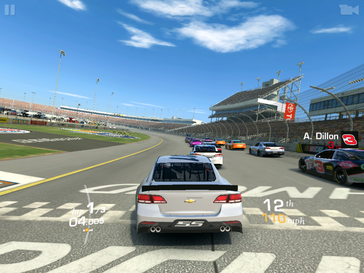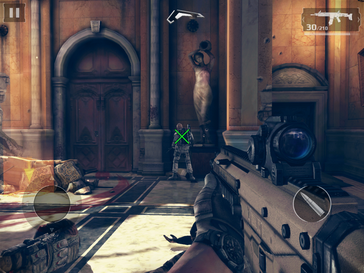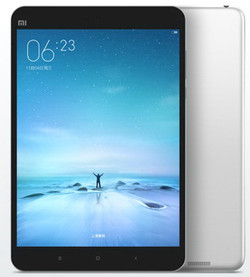Xiaomi MiPad 2 Tablet Review

For the original German review, see here.
Xiaomi offers a compact Android tablet in its second generation with its MiPad 2. It is lighter, thinner and smaller than its predecessor. Apparently, Xiaomi closely follows Apple's iPad Mini model in terms of design, choice of materials, size and screen resolution.
Intel's Atom X5-Z8500 64-bit quad-core processor enclosed in a metal unibody casing is inside the MiPad 2. The screen has a resolution of 2048x1536 pixels, which results in a very good 324 PPI at a size of 7.9-inches. It thus offers the Retina resolution known from Apple. The IPS panel by Sharp is protected by Corning Gorilla Glass 3. A highlight of the MiPad 2: It already integrates the twist and turn safe Type-C port. Data is transferred and the non-removable, 6190 mAh battery is recharged via the new USB 3.1 standard.
The MiPad 2's current availability can only be ensured via import retailers. It is not yet known whether or when it will be officially sold in Germany. Perhaps more information will be provided at the opening of the Mi.com shop in May. Importers demand a price starting at approximately 200 Euros for the colors Champagne Gold or Dark Gray.
Having virtually identical screen specs and comparable dimensions, the MiPad 2 could be a possible alternative for the more expensive Asus ZenPad S 8.0 and Apple iPad Mini 4, and also for the low-priced Archos 97 Titanium HD.
Case
Unlike its predecessor, Xiaomi uses a metal rather than plastic casing for its MiPad 2. It is made of matte, brushed aluminum, which gives the tablet a superb feel. At a size of 200.4 x 132.6 millimeters, the MiPad 2 is compact and its weight of 322 grams makes it pleasant to hold. The just 6.95 millimeter casing houses the 3.5 millimeter audio jack in addition to volume controls and power button. The tablet's plastic keys are well-built in total. The MiPad 2's front is completely covered by scratch-proof glass. Three touch-sensitive keys for controlling the tablet are below the display.
We have to generally praise the fact that the MiPad 2's casing is just as good as its considerably more expensive rivals in terms of build and stability. The stiffness is also very good. Nothing dents even under high pressure (no cracking noises).
Connectivity
The 16 GB internal eMMC flash memory is quite tight without storage expansion and makes buying the bigger 64 GB version recommendable. After deducting the operating system and preloaded apps, only 12.93 GB is available for personal use in the 16 GB model.
In addition to recharging the battery, the USB Type-C port also acts as the OTG host via OTG adapter, and it supports accessing external USB flash drives. However, mice and keyboards can also be connected to the tablet. A status LED, Wireless Display and the Fast Charge option are other highlights for a device from this price range.
Software
The MiPad 2 is not quite as up-to-date in terms of the used Android 5.1 Lollipop version. Xiaomi covers that with the seventh iteration of the proprietary MIUI user interface (V7). The user interface, analogous to the casing, visibly leans on Apple's iOS. Both the apps' design and controls look familiar.
MIUI V7 offers multiple additional features and customization options. The desktop can be altered according to personal taste. The screen's portion of blue light can be reduced in read mode and should make reading texts more comfortable. Another feature: Windows 10 can be installed on the MiPad 2 (64 GB model). The user officially has to decide which operating system, Android or Windows, is to be used. The MiPad 2 firmware is only available in Chinese or English.
Communication & GPS
The Wi-Fi module in the MiPad 2 supports the 802.11 ac standard, enabling theoretical data speeds of up to 1.3 GBit/s. Beyond that, it supports dual-band and thus using the 5 GHz band via the 802.11 ac is possible. The reception quality was very good in real-world use, and the Wi-Fi signal was stable. The tablet does not have a SIM-card slot for mobile Internet access. Xiaomi does not install a GPS module in the MiPad 2, either. The latest Bluetooth 4.1 standard can be used for wireless communication between the tablet and other end devices.
Video test calls via Skype functioned without problems using the installed front-facing camera. Both the call quality and volume of the incorporated speakers are very satisfactory and do not give reason for complaint.
Cameras & Multimedia
The rear-facing primary camera in the MiPad 2 has a resolution of 8 megapixels. It features a CMOS pixel sensor and achieves an aperture of f2.0. The pictures taken with the MiPad 2 in our sharpness test (test chart photo in defined artificial light) are throughout high-detail but look a bit hazy toward the edges. The color accuracy, determined by photographing ColorChecker Passport in controlled light conditions, is very good; only black and white exhibit a very visible grayish tint.
The image quality was not really convincing in our practical test. The pictures shot with the MiPad 2 are sometimes too dark in different light conditions (loss of details: ambient photo) or looked faded (ambient photo). The pictures exhibited a visible blurriness in low-light conditions (indoor photo). However, the 5-megapixel front-facing camera can record videos, for Skype calls among other things, in 1080p, which is more relevant for a tablet. The image quality is good.
Accessories
In addition to the modular charger (EU connector), only the required data cable for connecting the tablet is included for the MiPad 2.
Warranty
The Xiaomi MiPad 2 is shipped with a one-year warranty from purchase date. Our review sample, provided by Trading Shenzhen, came with the option of sending the device to a German mailing address in case of warranty claim. Thus, time-consuming shipping to China would not be necessary.
Input Devices & Handling
The device is controlled via three illuminated, capacitive buttons below the screen. The capacitive multi-touch screen made a good impression in the test. Inputs were implemented accurately and without delays. The double-tap-to-wake feature for activating the tablet from standby was also detected without fail.
It becomes evident that the MiPad 2 was not made for the German market when looking at the preloaded virtual keyboard. The user can only select between a Chinese or English layout. The latter functioned satisfactorily in the test. Users who have problems with the preloaded QWERTY keyboard can find an alternative in the Play Store.
Display
The resolution of the LCD panel in the MiPad 2 is on par with rivals like the iPad Mini 4 or Asus ZenPad S 8. Content looks pleasantly sharp with a pixel density of 324 PPI on the 7.9-inch IPS screen.
The brightness measured at nine points shows a minor brightness loss toward the screen's edges. We measured a maximum brightness of 425 cd/m² in the center. An excellent rate that not even the iPad Mini 4 achieves. The IPS panel in the MiPad 2 also has an edge on its rivals in terms of black level and contrast. The brightness with enabled brightness sensor (max. 412 cd/m²) and evenly distributed dark and light areas (APL 50, 408 cd/m²) on the screen barely changed.
| |||||||||||||||||||||||||
Brightness Distribution: 91 %
Center on Battery: 425 cd/m²
Contrast: 1063:1 (Black: 0.4 cd/m²)
ΔE ColorChecker Calman: 4.98 | ∀{0.5-29.43 Ø4.77}
ΔE Greyscale Calman: 5.2 | ∀{0.09-98 Ø5}
Gamma: 2.65
CCT: 7249 K
| Xiaomi MiPad 2 HD Graphics (Cherry Trail), Z8500, 16 GB eMMC Flash | Apple iPad Mini 4 PowerVR GX6450, A8, 64 GB SSD | Archos 97 Titanium HD Mali-400 MP4, RK3066, 8 GB SSD | Asus ZenPad S 8.0 Z580CA PowerVR G6430, Z3580, 64 GB SSD | Samsung Galaxy Tab S2 8.0 LTE Mali-T760 MP6, Exynos 5433, 32 GB eMMC Flash | |
|---|---|---|---|---|---|
| Screen | 4% | -23% | -5% | 20% | |
| Brightness middle (cd/m²) | 425 | 411 -3% | 183 -57% | 369 -13% | 347 -18% |
| Brightness (cd/m²) | 402 | 421 5% | 180 -55% | 346 -14% | 348 -13% |
| Brightness Distribution (%) | 91 | 91 0% | 88 -3% | 86 -5% | 88 -3% |
| Black Level * (cd/m²) | 0.4 | 0.58 -45% | 0.26 35% | 0.37 7% | |
| Contrast (:1) | 1063 | 709 -33% | 704 -34% | 997 -6% | |
| Colorchecker dE 2000 * | 4.98 | 2.15 57% | 5.58 -12% | 1.67 66% | |
| Colorchecker dE 2000 max. * | 6.61 | ||||
| Greyscale dE 2000 * | 5.2 | 2.72 48% | 4.67 10% | 1.75 66% | |
| Gamma | 2.65 83% | 2.29 96% | 2.25 98% | 2.27 97% | |
| CCT | 7249 90% | 7012 93% | 7927 82% | 6361 102% | |
| Color Space (Percent of AdobeRGB 1998) (%) | 70 | 95.4 | |||
| Color Space (Percent of sRGB) (%) | 86 |
* ... smaller is better
The screen's quality is subjectively convincing in real-world use. Content is high in contrast and colors look vivid but not oversaturated. Objectively, the measurements with the Colorimeter (CalMAN software) resulted in a somewhat too cool color reproduction (7249 K). Both grayscale levels as well as the primary and mixed colors displayed clear shifts compared with the sRGB reference in their average DeltaE aberrations (target range: <3). In view of the price that Xiaomi demands for the MiPad 2, it is a satisfactory rate.
Display Response Times
| ↔ Response Time Black to White | ||
|---|---|---|
| 37 ms ... rise ↗ and fall ↘ combined | ↗ 5 ms rise | |
| ↘ 32 ms fall | ||
| The screen shows slow response rates in our tests and will be unsatisfactory for gamers. In comparison, all tested devices range from 0.1 (minimum) to 240 (maximum) ms. » 95 % of all devices are better. This means that the measured response time is worse than the average of all tested devices (20.2 ms). | ||
| ↔ Response Time 50% Grey to 80% Grey | ||
| 38 ms ... rise ↗ and fall ↘ combined | ↗ 15 ms rise | |
| ↘ 23 ms fall | ||
| The screen shows slow response rates in our tests and will be unsatisfactory for gamers. In comparison, all tested devices range from 0.165 (minimum) to 636 (maximum) ms. » 54 % of all devices are better. This means that the measured response time is worse than the average of all tested devices (31.6 ms). | ||
Screen Flickering / PWM (Pulse-Width Modulation)
| Screen flickering / PWM not detected | |||
In comparison: 53 % of all tested devices do not use PWM to dim the display. If PWM was detected, an average of 8080 (minimum: 5 - maximum: 343500) Hz was measured. | |||
Performance
Intel's Atom x5-Z8500 quad-core SoC from 2015 and 2 GB of LPDDR3 RAM are responsible for smooth performance inside the MiPad 2. We only experienced noteworthy system lapses or stuttering during excessive multitasking. A somewhat larger working memory would have very likely improved multitasking capabilities, but it is certainly dispensable in view of the price. The Internet and storage performances (sequential read and write, 4K block random access) are also convincing.
The relevant benchmarks confirm the subjective performance impressions. The MiPad 2 largely ranges on par with some more expensive Android opponents. However, it cannot compete with the performance of an iPad Mini 4 particularly in graphics-driven benchmarks.
| Geekbench 3 | |
| 32 Bit Multi-Core Score (sort by value) | |
| Asus ZenPad S 8.0 Z580CA | |
| 32 Bit Single-Core Score (sort by value) | |
| Asus ZenPad S 8.0 Z580CA | |
| 64 Bit Multi-Core Score (sort by value) | |
| Xiaomi MiPad 2 | |
| Apple iPad Mini 4 | |
| Samsung Galaxy Tab S2 8.0 LTE | |
| 64 Bit Single-Core Score (sort by value) | |
| Xiaomi MiPad 2 | |
| Apple iPad Mini 4 | |
| Samsung Galaxy Tab S2 8.0 LTE | |
| AnTuTu v6 - Total Score (sort by value) | |
| Xiaomi MiPad 2 | |
| GFXBench (DX / GLBenchmark) 2.7 | |
| T-Rex Onscreen (sort by value) | |
| Xiaomi MiPad 2 | |
| Apple iPad Mini 4 | |
| Asus ZenPad S 8.0 Z580CA | |
| Samsung Galaxy Tab S2 8.0 LTE | |
| 1920x1080 T-Rex Offscreen (sort by value) | |
| Xiaomi MiPad 2 | |
| Apple iPad Mini 4 | |
| Asus ZenPad S 8.0 Z580CA | |
| Samsung Galaxy Tab S2 8.0 LTE | |
| GFXBench 3.0 | |
| on screen Manhattan Onscreen OGL (sort by value) | |
| Xiaomi MiPad 2 | |
| Apple iPad Mini 4 | |
| Asus ZenPad S 8.0 Z580CA | |
| Samsung Galaxy Tab S2 8.0 LTE | |
| 1920x1080 1080p Manhattan Offscreen (sort by value) | |
| Xiaomi MiPad 2 | |
| Apple iPad Mini 4 | |
| Asus ZenPad S 8.0 Z580CA | |
| Samsung Galaxy Tab S2 8.0 LTE | |
| GFXBench 3.1 | |
| on screen Manhattan ES 3.1 Onscreen (sort by value) | |
| Xiaomi MiPad 2 | |
| Asus ZenPad S 8.0 Z580CA | |
| 1920x1080 Manhattan ES 3.1 Offscreen (sort by value) | |
| Xiaomi MiPad 2 | |
| Asus ZenPad S 8.0 Z580CA | |
| GFXBench | |
| on screen Car Chase Onscreen (sort by value) | |
| Xiaomi MiPad 2 | |
| 1920x1080 Car Chase Offscreen (sort by value) | |
| Xiaomi MiPad 2 | |
| PCMark for Android - Work performance score (sort by value) | |
| Xiaomi MiPad 2 | |
| Asus ZenPad S 8.0 Z580CA | |
| Samsung Galaxy Tab S2 8.0 LTE | |
| JetStream 1.1 - Total Score (sort by value) | |
| Xiaomi MiPad 2 | |
| Samsung Galaxy Tab S2 8.0 LTE | |
| Octane V2 - Total Score (sort by value) | |
| Xiaomi MiPad 2 | |
| Apple iPad Mini 4 | |
| Asus ZenPad S 8.0 Z580CA | |
| Samsung Galaxy Tab S2 8.0 LTE | |
| Mozilla Kraken 1.1 - Total (sort by value) | |
| Xiaomi MiPad 2 | |
| Apple iPad Mini 4 | |
| Asus ZenPad S 8.0 Z580CA | |
| Samsung Galaxy Tab S2 8.0 LTE | |
* ... smaller is better
Games
Even if the DirectX 11.2 enabled graphics unit in the MiPad 2 does not come close to the performance of the Apple iPad Air 2, the HD Graphics (Cherry Trail) based on Intel's Gen8 architecture has enough power for smooth gaming performance. Demanding games like Real Racing 3 or Modern Combat 5 could be played without issues in the test.
Emissions
Temperature
The MiPad 2's surface temperatures were within an uncritical range for tablets in the test. Even during permanent full load, the device's surface never got unpleasantly warm not to say hot. The MiPad 2 averagely reached a maximum of 34.7 °C; it was just 31.6 °C in idle.
(+) The maximum temperature on the upper side is 38.6 °C / 101 F, compared to the average of 33.6 °C / 92 F, ranging from 20.7 to 53.2 °C for the class Tablet.
(+) The bottom heats up to a maximum of 36.9 °C / 98 F, compared to the average of 33.2 °C / 92 F
(+) In idle usage, the average temperature for the upper side is 30.6 °C / 87 F, compared to the device average of 30 °C / 86 F.
Speakers
The stereo speakers in the MiPad 2 are very loud for a compact tablet, with over 95 dB. The sound is clear, and mid and high frequency tones are well-differentiated. Basses are hardly audible. The Pink Noise evaluation illustrates that a very low volume is primarily achieved in the bass range, as expected.
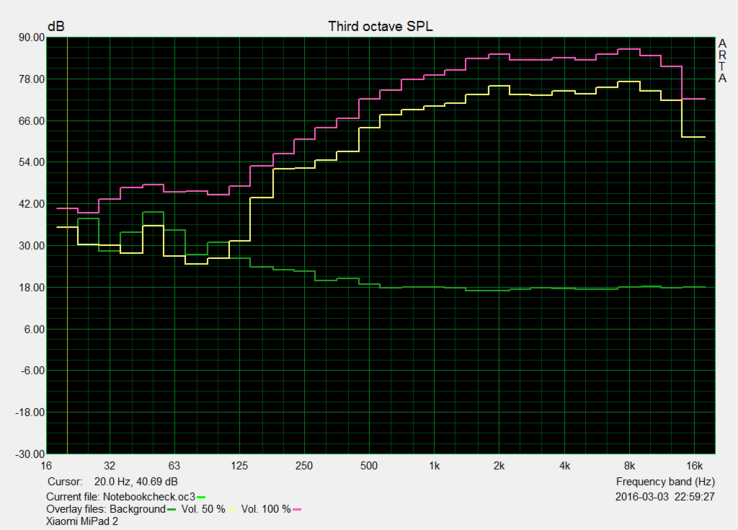
Energy Management
Power Consumption
The MiPad 2's idle power consumption is very high using minimum brightness and enabled flight mode. The high base consumption becomes evident when comparing the device's 3.33 watts with the measurements of the iPad Mini 4 (0.8 watts). The rate of 5.2 watts is clearly higher than that of the rivals also with maximum brightness and enabled communication modules. The power consumption even climbs to 9.3 watts in load conditions (Stability Test CPU + GPU). Only Archos' 97 Titanium HD surpasses that in the comparison field.
| Off / Standby | |
| Idle | |
| Load |
|
Key:
min: | |
Battery Runtime
Despite the relatively high power consumption, the 6190 mAh lithium-ion polymer battery achieved a runtime of 7 hours and 1 minute in the real-world battery test (brightness: 150 cd/m²). That is a good outcome compared with other Android tablets. However, it does not achieve the long runtime of the Apple iPad Mini 4 in the Wi-Fi test despite a much bigger battery.
| Xiaomi MiPad 2 HD Graphics (Cherry Trail), Z8500, 16 GB eMMC Flash | Apple iPad Mini 4 PowerVR GX6450, A8, 64 GB SSD | Asus ZenPad S 8.0 Z580CA PowerVR G6430, Z3580, 64 GB SSD | Archos 97 Titanium HD Mali-400 MP4, RK3066, 8 GB SSD | Samsung Galaxy Tab S2 8.0 LTE Mali-T760 MP6, Exynos 5433, 32 GB eMMC Flash | |
|---|---|---|---|---|---|
| Battery runtime | 29% | -19% | 6% | ||
| WiFi v1.3 (h) | 7 | 9 29% | 5.7 -19% | 7.4 6% | |
| WiFi (h) | 6.1 |
Pros
Cons
Verdict
Xiaomi shows the possibilities for a tablet from the entry-level price range with its 2nd generation MiPad. The aluminum casing adds a certain degree of quality and stability. It is pleasant to hold with its compact dimensions and a weight of 322 grams. The connectivity is also generous for this price range: USB OTG, status LED, Fast Charge and USB 3.1 Type-C are present. Furthermore, the cameras are useful and the speakers are exceptionally loud for a device of this size. Only the installed 2 GB of working memory (RAM) and non-expandable storage of 16 GB (ROM) seem a bit undersized - particularly for a tablet. Xiaomi does not incorporate either a GPS module or NFC.
On the other hand, the screen is absolutely convincing. Good black level, high contrast and very good viewing angles characterize the IPS panel in the MiPad 2. Content also looks pleasantly sharp with 324 PPI.
Despite, or perhaps just for, the multiple similarities with Apple's iPad Mini, Xiaomi has done many things right in the MiPad 2. A successful total package.
Due to the lack of availability on the German market, Xiaomi's MiPad 2 is, and will likely remain to be, a rare tablet here. The affordable tablet from the Far East could be a real alternative for the more expensive Android rivals like the ZenPad S 8.0 or even for Apple's iPad Mini 4 for buyers who venture ordering via import companies.
Xiaomi MiPad 2
- 03/14/2016 v5 (old)
Marcus Herbrich


